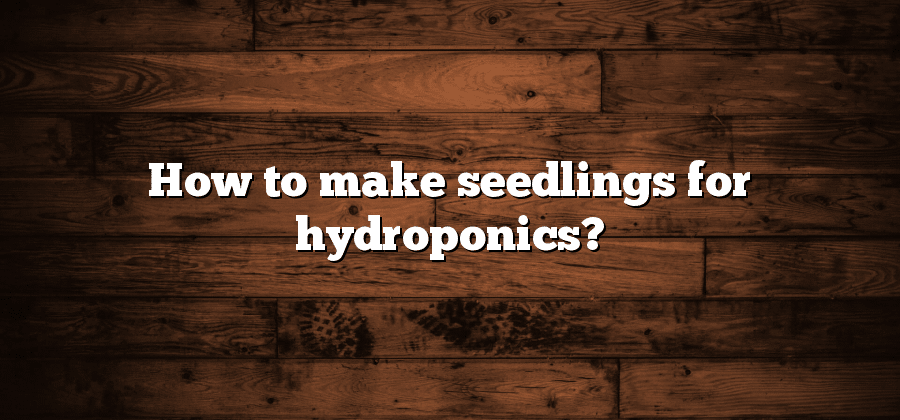Seedling Selection and Preparation
When it comes to growing plants through hydroponics, seedling selection and preparation play a crucial role in ensuring successful cultivation. The first step is to choose high-quality seeds from reliable suppliers. Look for seeds that are specifically labeled for hydroponic growth, as they are often bred to thrive in nutrient-rich water solutions. Additionally, consider the desired characteristics of the plant, such as its growth rate, disease resistance, and flavor profile, when selecting the right seed varieties.
Once the seeds are chosen, it’s time to prepare them for planting. Start by placing the seeds in a container filled with water and allow them to soak for a few hours or overnight. This step helps to hydrate the seeds and kickstart the germination process. After soaking, transfer the seeds to a damp paper towel or a germination tray lined with a moist growing medium. Keep the seeds in a warm and dark environment, such as a seedling dome or a propagator, to encourage rapid and healthy sprouting. Regularly check on the seeds to ensure they remain moist but not waterlogged, as proper moisture levels are essential for successful seedling establishment.
Ideal Growing Conditions for Seedlings
To ensure the optimal growth and development of your seedlings, it is crucial to provide them with the ideal growing conditions. Firstly, adequate light is essential for photosynthesis, the process by which plants convert light energy into chemical energy. Opt for a grow light that emits a full spectrum of light to mimic natural sunlight, as this will support healthy photosynthesis and promote sturdy stem growth.
Secondly, maintaining a suitable temperature is crucial for your seedlings’ success. Most plants thrive in temperatures between 65 and 75 degrees Fahrenheit (18 to 24 degrees Celsius). It is important to monitor and regulate the temperature in your growing area to avoid extremes that can hinder the growth of your seedlings. Using a thermostat-controlled heater or air conditioner can help maintain a stable and favorable temperature range.
Additionally, humidity plays a vital role in creating the ideal growing conditions for seedlings. Most seedlings prefer a relative humidity level of around 50 to 60%. You can monitor and adjust humidity levels in your growing area by using a hygrometer and implementing methods such as misting or using a humidifier when necessary.
Lastly, ventilation is essential for seedling success. Adequate airflow prevents the buildup of excessive moisture, which can lead to fungal diseases. Install small fans in your growing area to ensure air circulation without causing strong drafts that may disrupt the delicate seedlings.
By providing proper lighting, maintaining optimal temperatures, regulating humidity, and ensuring adequate ventilation, you can create the ideal growing conditions that will lead to robust and healthy seedlings. Remember, these conditions may vary depending on the specific plant species, so it’s essential to research the individual requirements of your chosen seedlings.
Choosing the Right Hydroponic System
When it comes to choosing the right hydroponic system for your indoor garden, there are several factors to consider. First and foremost, you need to assess the space available to you. Depending on the size of your garden and the number of plants you intend to grow, you may opt for a smaller or larger system. It’s crucial to ensure that your chosen system fits comfortably within your available space to avoid any potential issues later on.
Another important consideration is the type of plants you wish to grow. Different hydroponic systems are better suited to specific plant types. For instance, some systems are ideal for leafy greens, while others are more suitable for larger, fruit-bearing plants. Understanding the needs and requirements of the plants you want to cultivate is crucial in selecting the most appropriate hydroponic system. By paying careful attention to these factors, you can make an informed decision and choose the right hydroponic system that will create an optimal growing environment for your plants.
Selecting the Appropriate Growing Medium
Hydroponic systems provide an alternative method of cultivation that eliminates the need for soil. Instead, plants are grown in a nutrient-rich solution that supports their growth and development. To facilitate this process, selecting the appropriate growing medium is crucial.
There are several factors to consider when choosing a growing medium for hydroponic systems. One of the primary considerations is the type of plant being grown. Different plants have different root structures and nutrient requirements, which may influence the choice of medium. Additionally, the absorption and retention capabilities of the growing medium should be taken into account. Ideally, the medium should have excellent water-holding capacity while also allowing proper aeration and drainage. This ensures that the plants have access to water and oxygen without being waterlogged, which can lead to root rot and other issues. Consequently, finding the right growing medium for your hydroponic system is essential for the success of your plants.
Planting the Seeds in the Hydroponic System
When it comes to planting the seeds in a hydroponic system, there are several key considerations to keep in mind. Firstly, it is important to choose the right type of seeds for your desired crop. Opt for high-quality, disease-resistant seeds that are suited to hydroponic growing conditions. This will maximize your chances of success and ensure vigorous plant growth. Additionally, take into account the specific requirements of each seed variety, such as light and temperature preferences, as this will influence the overall success of your hydroponic garden.
Once you have selected the appropriate seeds, it is crucial to properly prepare them for planting. To enhance germination and minimize the risk of disease, many growers choose to soak the seeds in a diluted hydrogen peroxide solution or a mild bleach solution for a short period of time. This helps to disinfect the seeds and remove any potential pathogens. After soaking, rinse the seeds thoroughly with clean water before transferring them to their final planting location in the hydroponic system. Carefully follow the instructions provided by the seed supplier for best results.






